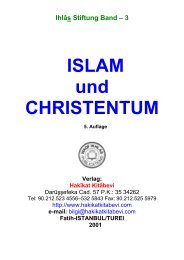1 - Endless Bliss - Hüseyin Hilmi Işık
1 - Endless Bliss - Hüseyin Hilmi Işık
1 - Endless Bliss - Hüseyin Hilmi Işık
You also want an ePaper? Increase the reach of your titles
YUMPU automatically turns print PDFs into web optimized ePapers that Google loves.
’Umar, Rasûlullah (sall-Allâhu ta’âlâ ’alaihi wa sallam) was<br />
telling you something yesterday. Tell us, so that we can know.”<br />
He (the Prophet) always used to say, “Tell your brothers-in-<br />
Islam what you hear from me! Let one another know!”<br />
Hadrat ’Umar said, “Yesterday Abû Bakr (radî Allahu ’anh) had<br />
asked him about the meaning of an âyat which he couldn’t<br />
understand, and Rasûlullah was explaining it to him. I listened<br />
for an hour, but I couldn’t understand anything.” He was<br />
explaining everything according to the high grade of Abû Bakr.<br />
Hadrat ’Umar was so great that Rasûlullah said, “I am the Last<br />
Prophet. No Prophet will succeed me. If there were a<br />
prophet to succeed me, ’Umar would be that prophet.”<br />
Though he was so great and knew Arabic very well, he was not<br />
able to understand even the explanation of the Qur’ân.<br />
Rasûlullah used to explain it according to the degree of the<br />
person. The degree of Abû Bakr was much higher than Hadrat<br />
’Umar’s. But he, too, and even Hadrat Jabrâil used to ask<br />
Rasûlullah about the meaning, about the mysteries in the<br />
Qur’ân. [The book al-Hadîqa, while explaining the disasters<br />
incurred by the tongue, communicates that Imâm-i Suyûtî wrote<br />
that Rasûlullah explained the interpretation of the whole Qur’ân<br />
to the Ashâb-i kirâm.]<br />
In short, only Hadrat Muhammad understood the meaning of<br />
the Qur’ân and explained it through his hadîths. It is he who<br />
interpreted the Qur’ân. The correct book of interpretation is his<br />
hadîths. By not sleeping or resting, by sacrificing their repose,<br />
our religious scholars gathered these hadîths and wrote books<br />
of interpretation. The book of interpretation entitled Baydâwî is<br />
one of the strongest among them. To understand even these<br />
books of interpretation, it is necessary to learn the twenty main<br />
branches of knowledge well by working ceaselessly for thirty<br />
years. There are eighty subdivisions that are the branches of<br />
these twenty main branches of knowledge. One of the main<br />
branches is the knowledge of tafsîr (interpretation). These<br />
branches of knowledge had different savants and many books.<br />
Various Arabic words that are used today have different<br />
meanings in the knowledge of fiqh than from the meanings<br />
which they have in the knowledge of interpretation. Even the<br />
same word conveys different meanings according to its place in<br />
the Qur’ân and the particles it takes. The Qur’ân’s translations<br />
by those who do not know these vast branches of knowledge or<br />
- 77 -




